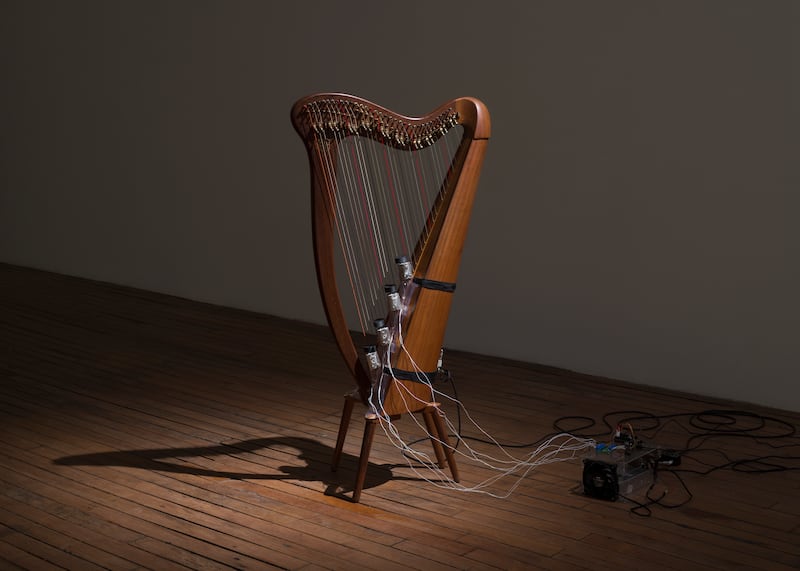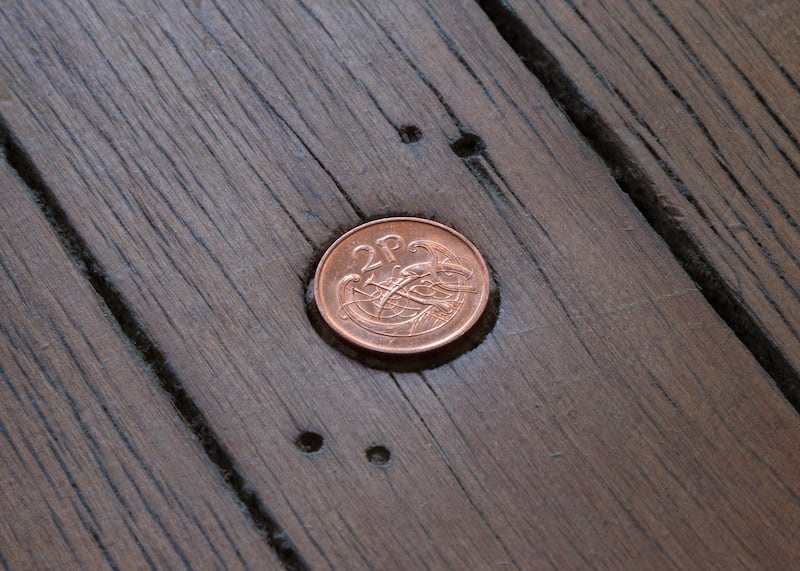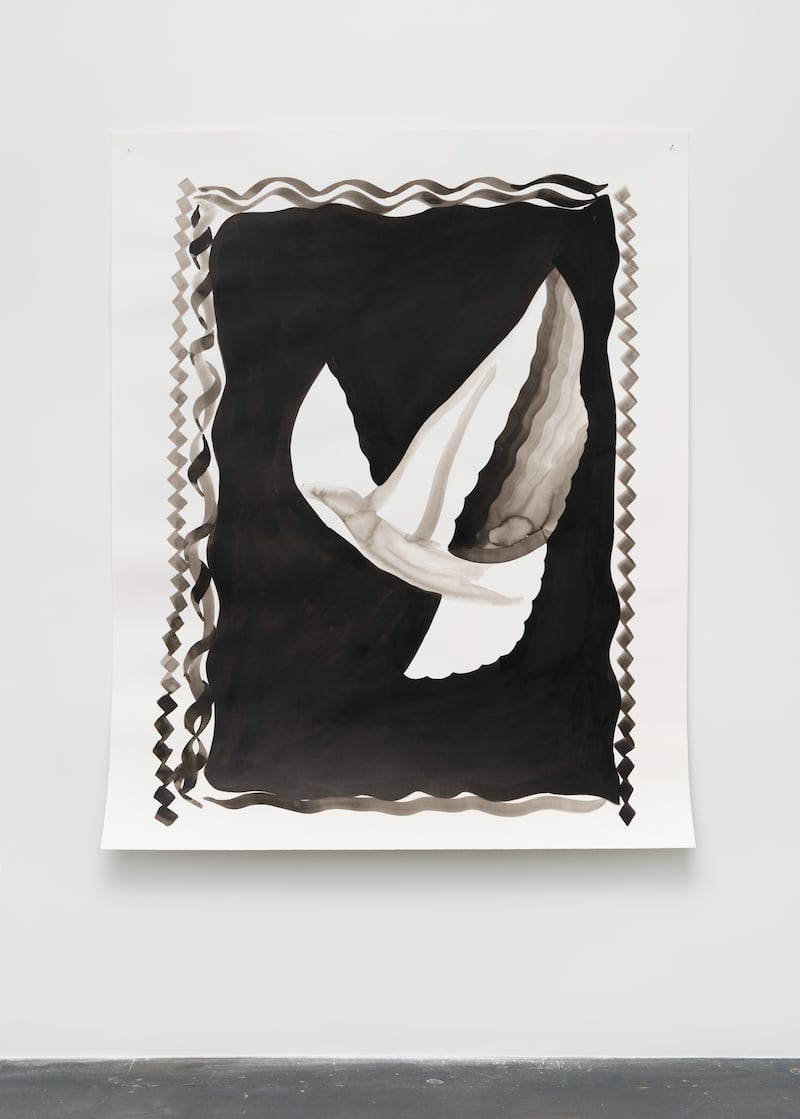It about 35 degrees on the streets of Tribeca, as New York battles yet another heatwave. The Bureau gallery, on Duane Street, is strangely serene, however. A harp is playing itself, little machines plucking at its strings now and then, with perfect dissonance. A large pewter incense burner hangs on a long chain from the ceiling, emitting a haze of frankincense. Large black-and-white ink paintings adorn one wall. A small drawing of a Confession box hangs on another. Downstairs, a video piece blending 3D animation, images of nature and strobing poetry lights up a darkened room.
This is The Song of Lies, Vivienne Griffin’s latest solo exhibition, supported in part by Culture Ireland. Griffin, from Dublin but living in London, is an artist whose work induces calm and unease. “I met Vivienne when they were getting their MFA at Hunter,” the gallery’s founder, Gabrielle Giattino, says. “Vivienne was in our very first group show when we opened in 2010. Our first space was probably the size of this desk, on Henry Street in Chinatown, a storefront. Vivienne had a solo show in 2013. We moved to Norfolk Street, on the Lower East Side, and just moved here in March ... Looking specifically at Vivienne’s minimalism, there’s an emotional level there. I was really drawn to that. There’s a softness.”

In the early 2000s Griffin was working in the costume department of an opera company when a piece of set design by Bruno Schwengl – “a giant white cube built out of light, just this really minimalist set” – blew their mind. “I was absolutely obsessed with it,” they tell me later, over video from London. “I was, like, ‘I want to do set design’.”
Unable to find a relevant college course, Griffin spoke to Schwengl, who said he studied fine art. So, at 25, Griffin went to Cork to study at Crawford College of Art and Design. “I thought, I’ll do art, and then I’ll get into theatre. But when I got into art the whole thing just opened up. It was really exciting for me to find out that this world existed that I didn’t know about. Then I just went on a full art bender and never came back.”
After graduating, deciding that they wanted to leave Ireland, and looking for funding opportunities, Griffin applied for a “long shot”, a Fulbright scholarship, thinking, “If this happens it’ll be amazing. And it did, and I got matched funding from the Arts Council, and I moved over there with my kid.” There was New York, where Griffin studied for a master’s degree in fine art at Hunter College, got a studio in Hell’s Kitchen and had “some amazing tutors, like Constance DeJong, who is also represented at [Bureau], literally a legend. She’s really cool. Hard core. She was challenging as a tutor, but that was really helpful. I had Nari Ward, who is an American artist: he’s amazing. I also had Paul Ramírez Jonas.”
Griffin didn’t struggle to “basically produce artwork or thrive in those kinds of environments – that side of it is fine. But in relation to how you get money to survive in New York for that amount of time? That’s challenging.”

What followed was a succession of ever-evolving exhibitions and work in a variety of contexts: House Projects in Brooklyn, shows at Bureau, multiple works at Drop Everything on Inis Oírr, work in Lithuania, Latvia, Romania and Cologne, and an increasing number of shows in London, where Griffin works in space they were awarded at Somerset House Studios. “I have this connection to natural phenomena, nature, but it comes out in weird ways. It doesn’t necessarily come out as an ecological comment. It might be more about a way of processing your relationship with the world, essentially. How do you process it? Visual art is a language. Sound is a language. You’re having a dialogue through those mediums to process your experience of the world, or of being alive, or of being human.”
Of the large works in ink at Bureau, Griffin engaged in a process with artificial intelligence that produces utterly human results. Griffin used a model trained only on their drawings. “I’m not prompting the AI ... It’s not using data sets from anywhere else.” The work emerged gradually; then Griffin made it by hand with ink and brush. “There’s two major things where it came from. One is a Pauline Oliveros thing” – Oliveros was an American composer, theorist and sound artist – “where she said she wanted to get emancipatory prompts from technology. Since big tech has taken over, that opportunity has mostly been annihilated, but not fully. Because now it has become these tools of surveillance, tools of capitalism. They’ve not become emancipatory tools. That was one thing I was looking for. The other thing was a couple of books that were made with AI, where AI speaks and the author responds. I was, like, ‘Is there any way we can merge, and those boundaries aren’t binary, that they’re a collaborative process?’ I was looking for that in my work.”

The result is a delicate richness residing within Griffin’s own approach to minimalism. There are also playful moments, such as four hard-to-find Irish 2p coins wedged in circular holes on the gallery floor. They were inspired by a remark about one of their large black-and-white ink artworks. “A friend who lives in Berlin was, like, ‘That looks like the 2p coin design.’ I was, like, ‘What?’ and then, ‘Yeah!’ It all connected together then.”
The effect of the connections that Griffin is creating both within their work and outwards, to the world, is the conjuring of something totally original alongside occasionally familiar objects. “I didn’t go, ‘I’m going to make a sacred space.’ But there is something about working at a time when the world feels so intensely violent, with what’s happening in Palestine. It feels so aggressive. It is a difficult time to make work in that sense, because what are you responding to? My response was to try and maybe be reflective, I guess, and thoughtful. It wasn’t intentionally to make a spiritualistic or sacred space, but maybe it did come out that way.”
The Song of Lies, by Vivienne Griffin, is at the Bureau gallery in New York City until Friday, August 16th


















